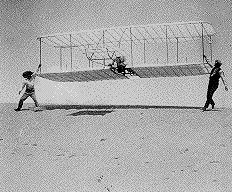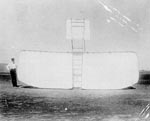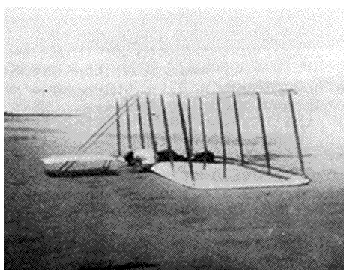1901 Aircraft Interactive
The simulation below is a computer drawing of the Wright brothers’ 1901 aircraft. This was the second unpowered aircraft built by the brothers. The aircraft was flown repeatedly at Kitty Hawk, North Carolina, during 1901 as a piloted glider and as a kite. The Wright brothers used this aircraft to further investigate the fundamentals of aerodynamics which they had begun in 1900. You can learn the same things in the same way by flying your own kite or glider. It’s fun!
You can study the design of the 1901 aircraft by changing the view using the buttons at the bottom of this JavaScript program.
Please note: the simulation below is best viewed on a desktop computer. It may take a few minutes for the simulation to load.
Aircraft Design
 The 1901 aircraft was larger than the 1900 aircraft, but of the same basic design; it has two wings, no tail, and an elevator/stabilizer mounted in the front of the aircraft. The wing span was increased from 17.5 to 22 feet and the chord (front edge of wing to back edge) was changed from 5 to 7 feet, making the overall wing area increase from 165 square feet to 290 square feet.The intent was to provide more lift so they could pilot their glider in winds of less velocity. Without the pilot, the 1901 craft weighed about a hundred pounds.
The 1901 aircraft was larger than the 1900 aircraft, but of the same basic design; it has two wings, no tail, and an elevator/stabilizer mounted in the front of the aircraft. The wing span was increased from 17.5 to 22 feet and the chord (front edge of wing to back edge) was changed from 5 to 7 feet, making the overall wing area increase from 165 square feet to 290 square feet.The intent was to provide more lift so they could pilot their glider in winds of less velocity. Without the pilot, the 1901 craft weighed about a hundred pounds.
The pilot would lie on the bottom wing and control the roll of the aircraft by using a foot pedal. The pedal is connected to wires which pull on the wing tips and warp, or twist, the wing. Warping produces unequal forces on the wings which would roll the aircraft. On the 1901 aircraft, the pilot could also change the shape of the elevator to control the up/down position of the nose of the aircraft. This is called the pitch of the aircraft.
 The aircraft was flown frequently up to 300 feet in a single glide, but it did not perform as well as the brothers had originally expected. The aircraft only developed 1/3 of the lift which was predicted by the lift equation using the data published by the German, Otto Lilienthal. Lilienthal was the world’s foremost authority on aeronautics and had died in a glider accident in 1897. The brothers installed additional struts on the lower wing to alter the camber (curve) of the aircraft wing in an effort to improve the flying characteristics.
The aircraft was flown frequently up to 300 feet in a single glide, but it did not perform as well as the brothers had originally expected. The aircraft only developed 1/3 of the lift which was predicted by the lift equation using the data published by the German, Otto Lilienthal. Lilienthal was the world’s foremost authority on aeronautics and had died in a glider accident in 1897. The brothers installed additional struts on the lower wing to alter the camber (curve) of the aircraft wing in an effort to improve the flying characteristics.
Additional Struts
 In this photo of the aircraft, taken immediately after landing, you can see the additional struts between the wings at the center. During their test flights the brothers encountered an effect known as adverse yaw. On some flights, when the wings were warped to produce a roll which should have resulted in a curving flight path in the direction of the lower wing, the increased drag on the upper wing twisting in the opposite direction caused the air speed to decrease and the plane to settle back and turn into the ground. In one of these crashes Wilbur was thrown into the elevator, banged about, and ended up with bruises and a black eye. After that they only flew this craft as a kite.
In this photo of the aircraft, taken immediately after landing, you can see the additional struts between the wings at the center. During their test flights the brothers encountered an effect known as adverse yaw. On some flights, when the wings were warped to produce a roll which should have resulted in a curving flight path in the direction of the lower wing, the increased drag on the upper wing twisting in the opposite direction caused the air speed to decrease and the plane to settle back and turn into the ground. In one of these crashes Wilbur was thrown into the elevator, banged about, and ended up with bruises and a black eye. After that they only flew this craft as a kite.
By the end of 1901 flying season, the brothers were frustrated and Wilbur remarked that humans would not learn to fly in his lifetime. Aeronautic pioneer Octave Chanute asked Wilbur to give a lecture about their experiments to a meeting of the Western Society of Engineers. After the talk Chanute convinced Wilbur that they must continue, as no one else at the time had near the grasp of the principles of flying as he and Orville.
The First Wind Tunnel
When Wilbur returned to Dayton, the brothers suspected that the lift data from Lilienthal might not be correct. To test this idea, they fastened a bicycle wheel horizontally to the front of a bicycle, placed an airfoil shape and a flat plate on opposite sides, and rode off to create wind. The angle at which the wing had to be placed to balance the plate was far from that predicted by Lilienthal. At this point they decided they needed to gather their own data. They constructed their own wind tunnel with both lift and drag balances made out of old hacksaw blades and bicycle spokes. It took them a month to develop a smooth air flow, and over the period of the next two months they tested over 200 small wings of different shapes and sizes and in different combinations. Fifty of the configurations were subjected to careful parametric studies.
The results were another Wright brother first – the first real usable and accurate aerodynamic data obtained by experimenting with a wind tunnel. These results would be applied to the 1902 aircraft, which would answer many of the questions raised by the 1901 aircraft as they progressed toward the successful 1903 flyer.
